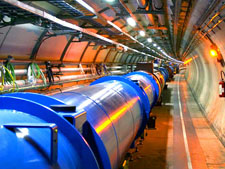Watch the LHC particle accelerator in action on March 30

A portion of the Large Hadron Collider
For more than 15 years, the Brandeis high-energy physics group has been collaboratively involved in building the world’s largest physics experiment for the Large Hadron Collider (LHC). Straddling France and Switzerland, deep underground in a 17-mile tunnel, the ATLAS experiment, as it is called, will recreate the physical conditions of our universe less than a billionth of a second after its birth in the Big Bang.
On Tuesday, March 30, the LHC, the world’s biggest particle accelerator, will circulate proton-smashing beams at the highest energy ever achieved, 7 TeV (3.5 TeV per beam). In collaboration with other Boston-area universities, the high-energy physics group, led by physicist James Bensinger, is responsible for the LHC’s endcap muon system, designed to capture muons, subatomic particles like electrons, but 200 times as massive.
“We believe muons are signatures of interesting events,” says Bensinger, adding that detecting these particles could lead to the holy grail of physics—that obscure “theory of everything.”
You can read more about the LHC collision event here. Video of the event will be webcast from CERN and shown live at Brandeis in Abelson 131 from 8:30 a.m. to 1:15 p.m. on March 30.





